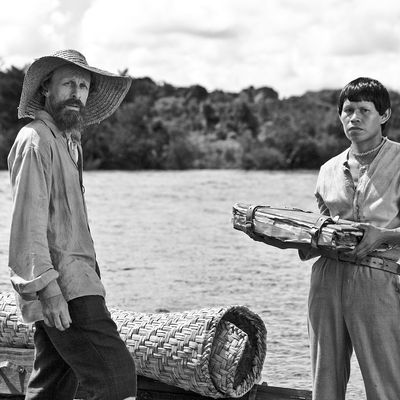
What a strange, even loco mix of tones youÔÇÖll encounter in Ciro GuerraÔÇÖs Embrace of the Serpent, an entrancing, black-and-white Amazon-rain-forest odyssey that takes place in two different eras ÔÇö roughly 40 years apart ÔÇö and seems to veer off into a new narrative tributary every 15 or so minutes. ItÔÇÖs another in a long, honorable line of films that chart the poisonous effects of colonialism on indigenous populations and their ecosystems, but with an unusually invigorating perspective, like a reverse-angle Heart of Darkness. Guerra is less interested in the impact of ÔÇ£savagesÔÇØ on the psyches of civilized white people than that of narcissistic, imperialist, predatory-capitalist, Bible-bearing ÔÇ£civilizedÔÇØ whites on the psyches of tribes that have lived in more or less the same fashion for millennia ÔÇö and whose members have little in the way of psychological defenses to protect themselves from assholes with agendas. He makes you understand why so much up the Amazon remained Dantesque even when the colonialists decamped.
In the first decade of the 20th century, a half-naked Amazonian shaman named Karamakate squats by a river ÔÇö probably the Vaup├®s, on the border between Colombia and Brazil ÔÇö and listens to the approach of a canoe. Played by Nilbio Torres, he is small but tautly muscled, with thick legs and a broad back. HeÔÇÖs an ┬¡amazing-looking guy. Karamakate does not like white people, having seen his tribe and its culture virtually wiped out by brutal Colombian rubber barons, so when that canoe arrives bearing the deathly ill German explorer-ethnographer┬¡ Theodor Koch-Gr├╝nberg (Jan Bijvoet) and a guide named Manduca (Yauenk├╝ Miguee), he refuses to treat the man. But he has lived alone for a long time, and, when Theodor claims that there are members of his tribe still alive, Karamakate blows some healing powder up the white manÔÇÖs nostril and joins the expedition. They are hardly under way when another Amazonian squats by the same river and listens to the approach of a canoe. It is the older Karamakate (Antonio Bol├¡var Salvador), who still lives alone, and his visitor is a rather curt American, Richard Evans Schultes (Brionne Davis), laden with books written long ago by Koch-Gr├╝nberg. Schultes claims he is unable to dream and is in search of a rare hallucinogen with healing powers called yakruna. The mournful old Karamakate ÔÇö who has forgotten ÔÇ£the gifts that the gods gave usÔÇØ ÔÇö goes along for this expedition, too.
As odysseys go, Embrace of the Serpent is wobbly. It feels like a shaggy-dog story, and it is. But its detours in both time frames ÔÇö those narrative tributaries ÔÇö turn out to be the real story. In between navigating the rapids, the explorers come to places that are neither ancient nor modern, native nor colonialist. TheyÔÇÖre crazed hybrids, like things smushed together on a molecular level in Seth BrundleÔÇÖs telepod in The Fly. In a remote mission, a Capuchin monk whips boys half to death to purge them of their ÔÇ£cannibalism and ignorance.ÔÇØ Hideously mutilated natives scamper among rubber trees, hoping the sap will forestall future assaults. In the modern time frame, Karamakate and Schultes stumble into a compound ruled by a self-appointed Christ: It looks like a combination of Apocalypse Now and a road-company production of Godspell ÔÇö but itÔÇÖs not so funny to see children on makeshift crucifixes punctured by arrows. WhatÔÇÖs left of KaramakateÔÇÖs people evokes the tragedy of all indigenous peoples stripped of their culture and supplied with intoxicants to dull the pain.
Embrace of the Serpent has its share of shamanic mumbo-jumbo that skeptics like me can take or leave, although Guerra buttresses its mysticism with astounding images of a giant anaconda winding, unwinding, and even giving birth in an Amazonian river that conforms to its shape. Through the two Karamakates, the movie suggests that these natives have been robbed not of actual magic but of knowledge, and are unable to perform the sacred task of all humans ÔÇö to pass their knowledge on to the next generation. The movie makes you see with your third eye.
*This article appears in the February 22, 2016 issue of New York Magazine.


